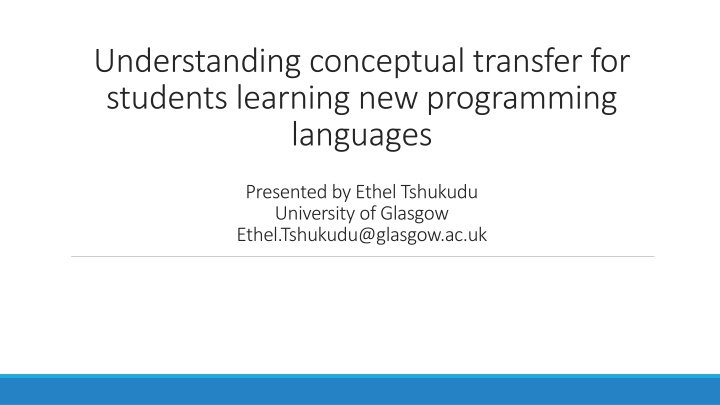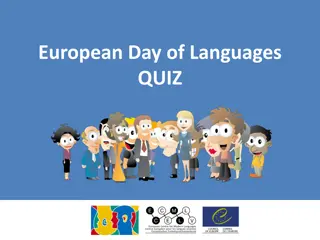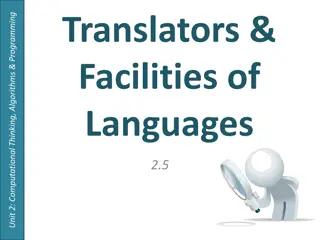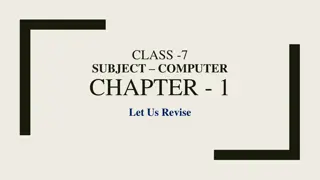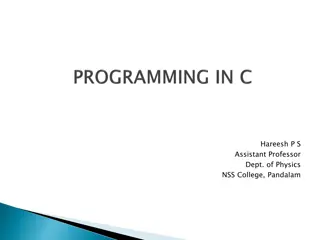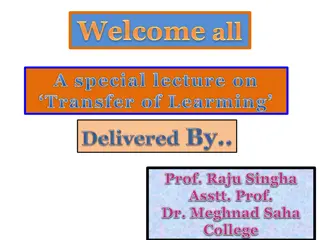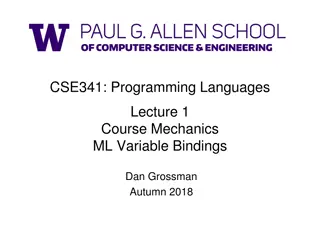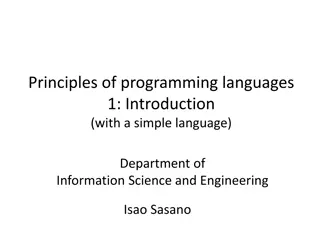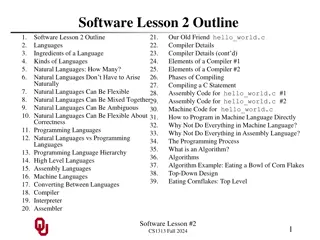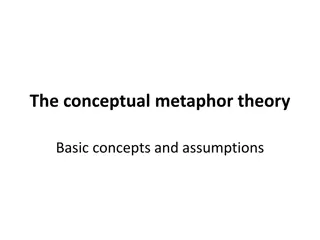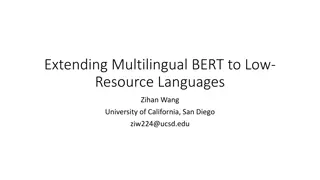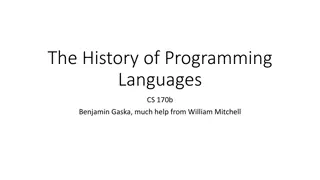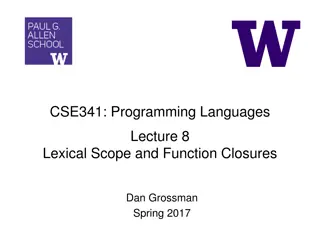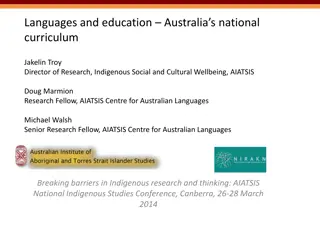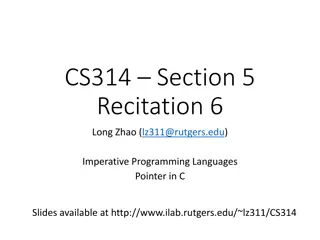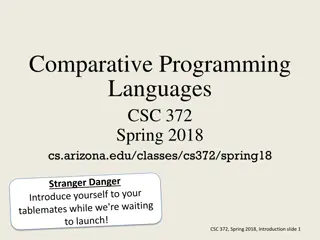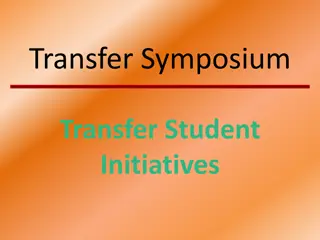Conceptual Transfer in Learning New Programming Languages
Ethel Tshukudu from the University of Glasgow explores the challenges and solutions related to conceptual transfer for students transitioning between programming languages. The research delves into transfer theories, preliminary studies, motivational factors, and implications for teaching. It also investigates the impact of semantic transfer on improving learning outcomes in programming languages.
Download Presentation

Please find below an Image/Link to download the presentation.
The content on the website is provided AS IS for your information and personal use only. It may not be sold, licensed, or shared on other websites without obtaining consent from the author.If you encounter any issues during the download, it is possible that the publisher has removed the file from their server.
You are allowed to download the files provided on this website for personal or commercial use, subject to the condition that they are used lawfully. All files are the property of their respective owners.
The content on the website is provided AS IS for your information and personal use only. It may not be sold, licensed, or shared on other websites without obtaining consent from the author.
E N D
Presentation Transcript
Understanding conceptual transfer for students learning new programming languages Presented by Ethel Tshukudu University of Glasgow Ethel.Tshukudu@glasgow.ac.uk
Outline Motivation Background Natural Languages Transfer Theories Research Questions Preliminary study and Findings Hypothesis for Quantitative study Study 1 and Study 2 and findings Implications to Teaching Implications to Block-based to Text-based transfer
Motivation Reported difficulties of transitioning between programming languages blocks to text-based languages (e.g K lling et al. 2015) Between text-based languages (e.g Nelson et al. 1997) There is no model that attempts to explain why transition problems exist in programming languages
Background Existing work on transfer Transfer to first Programming Languages (Qian et al. 2017, Stefik et al. 2013) Transfer between programming languages (Scholtz and Wiedenbeck, 1990s) Problem solving, Plan transfer, experienced programmers What is lacking on transfer Code comprehension, Novices, Semantic /conceptual transfer
Existing Transfer theory from Natural Languages Existing Transfer theory from Natural Languages o If you see la musique in French, what do you think it means? o If you see D ception in French, what do you think it means? That s covered in semantic transfer theory
Purpose of Research Purpose of Research RQ1) How is semantic transfer in natural languages applicable to learning new Programming Languages? RQ2) Does paying attention to semantic transfer during instruction improve transfer?
Starting point : Starting point : (Preliminary Qualitative Study 1) (Preliminary Qualitative Study 1) 5 second year University students transitioning from Procedural Python to OO java Study conducted for a semester (11 weeks) 1 hour fortnight individual sessions Code comprehension exercises Think-aloud protocols
Key findings +ve transfer for concepts that had similar syntax and semantics (e.g variables, conditional-statements, methods and parameter passing) -ve transfer for concepts that had similar syntax but different semantics (e.g reassigning a variable to a different type) No transfer for concepts that had different syntax but similar semantics (e.g objects and dictionaries which both resemble record structures)
Hypothesis for quantitative studies based on study 1 results Similar syntax and similar semantics between prior and new language results in positive semantic transfer and positive learning Similar syntax but different semantics between prior and new language results in negative semantic transfer and negative learning Different syntax but same semantics between prior and new language results in no or little semantic transfer and negative learning
Study 1 Study 1 120 participants (only 70 with no Java experience evaluated) Undergraduate students in second year Transitioning from procedural Python to OO Java Within-participant design Paper based code comprehension exercises in both Python and Java Pre-quiz (week 3) Interventions by instructor (week 5) Points out similarities and differences Post-quiz (week 9)
Study 2 Study 2 277 participants (with no Java exposure) Undergraduate students in second year Transitioning from OO Python to OO Java Within-participant design Code comprehension exercises in both Python and Java Online quiz was given out in lecture 1 before they learn Java
Sample constructs/concepts tested in both study 1 and 2 Similar syntax and similar semantics Similar syntax but different semantics
Study 1 and 2 Findings Used non-parametric Wilcoxon test on mean score between Python and Java quizzes No significant difference for concepts with similar syntax and semantics in Python and Java. Learning positive (e.g. functions, while loops, if statements) Significant difference for concepts with similar syntax but different semantics in Python and Java. Learning negative (e.g. for loop scoping, integer division, array equality) Significant difference for concepts with different syntax but similar semantics in Python and Java. Learning negative (e.g objects). Study 1 participants struggled more to shift to objects that Study 2 participants In Study 1, the intervention by the instructor improved the transfer. 56% of the students believed it helped them. Performance on all concepts was significantly improved in the post quiz.
Implications to teaching Educators can: Take advantage of concepts with similar syntax and semantics to teach a new language Explicitly teach concepts with similar syntax but different semantics and take it as opportunity to teach deeper programming concepts Use mapping of syntax between languages to help students transfer in concepts that have different syntax but same semantics
Implications to teaching for transfer from block based to text based Implications to teaching for transfer from block based to text based Future Research Possibilities Future Research Possibilities Teaching of block based languages should not only focus on problem solving but also on conceptual knowledge ( e.g. iteration, variables, data structures) Automatic transfer might occur where concepts have similar syntax and semantic e.g (if-conditionals between Python and Java) taken from www.futurelearn.com
Implications to teaching for transfer from block based to text based Explicit pointing of similarities and differences between languages where syntax is different but similar semantics e.g (string concatenation between Python and Java) taken from www.futurelearn.com Block-based language designers can use syntax that is similar to common programming languages used in education such as Java and Python to help with automatic transfer.
References Michael K lling, Neil CC Brown, and Amjad Altadmri. 2015. Frame-based editing: Easing the transition from blocks to text-based programming. In Proceedings of the Workshop in Primary and Secondary Computing Education. ACM, 29 38 H James Nelson, Gretchen Irwin, and David E Monarchi. 1997. Journeys up the mountain: Different paths to learning object-oriented programming. Accounting, Management and Information Technologies 7, 2 (1997), 53 85. Quanfeng Wu and John R Anderson. 1990. Problem-solving transfer among programming languages. Technical Report. CARNEGIE-MELLON UNIV PITTSBURGH PA ARTIFICIAL INTELLIGENCE AND PSYCHOLOGY Andreas Stefk and Susanna Siebert. 2013. An empirical investigation into programming language syntax. ACM Transactions on Computing Education (TOCE) 13, 4 (2013), 1 40. Jean Scholtz and Susan Wiedenbeck. 1990. Learning second and subsequent programming languages: A problem of transfer. International Journal of HumanComputer Interaction 2, 1 (1990), 51 72 Yizhou Qian and James Lehman. 2017. Students misconceptions and other difculties in introductory programming: A literature review. ACM Transactions on Computing Education (TOCE) 18, 1 (2017), 1 24
Questions and Answers Ethel Tshukudu University of Glasgow Other Contacts: 2371984t@student.gla.ac.uk Twitter: @etheltshukudu
